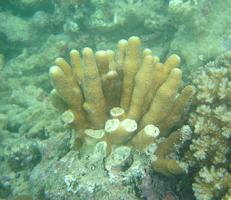Tidal wave aftermath-Any impact is big impact for coral reefs – conservationists |17 January 2005

While at first glance the loss may sound minor, the vulnerable state of coral reefs in Seychelles since the 1998 bleaching event – which killed as much as 90 percent of hard corals – leaves little room for error, says Pierre-Andre Adam, an assistant conservation officer at the Ministry of Environment and Natural Resources’ marine unit.
Even losing small amounts of coral cover will result in a more difficult recovery in the future, he said.
Conducted jointly by the Seychelles Centre for Marine Research and Technology and the marine unit, the study produced a preliminary report based on findings from the east coast of Mahe. Unfavourable weather conditions prevented the research team from surveying other areas, Mr Adam said.
The report concluded that the impact of the tidal waves seem to be related to reef structure. Granitic reefs like Grand Rocher suffered less damage to live coral as opposed to carbonate reefs, such as Moyenne or Anse Cimetierre, apparently due to there being less loose rubble.
Another concern highlighted in the report was that the heavy rains to follow the tidal waves caused a decrease in the salinity of the sea water. Mr Adam said sedimentation caused by surface run-off may cause extensive coral bleaching.
The report has been submitted to the Coral Reef Degradation in the Indian Ocean (CORDIO) and the World Conservation Union (IUCN), with a request for funding for more in-depth studies.
Recently at a side-event to the Small Island Developing States meeting in Mauritius, President James Michel noted there had been pledges of support for saving coral reefs, but did not go into great detail. The president had hosted a meeting through the International Coral Reef Initiative (ICRI), which was attended by UN Secretary General Kofi Annan, other senior UN officials and various heads of state.
According to Mr Adam, a thorough survey around the inner granitic islands will need to be conducted to better assess the damage caused by the tidal wave. He said this was important since the impacts may vary depending on conditions from reef site to reef site.
Future surveys will cover coral damage but also other forms of marine life, including fish, sea urchins and sea cucumbers and other invertebrates, which were seen to have been washed up on land after the tidal wave.




